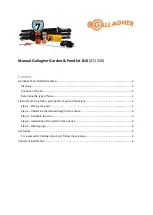
7
ENGLISH
HOT/COLD PACK DELAY
SC121
When the charger detects a battery that is hot, it automatically
delays charging until the battery has cooled.
When the charger detects a battery that is cold, it automatically
delays charging until the battery has warmed.
The red light will continue to blink, but a yellow indicator light
will be illuminated during this operation. Once the battery has
cooled, the yellow light will turn off and the charger will resume
the charging procedure.
Stanley Li-Ion tools are designed with an Electronic Protection
System that will protect the battery against overloading,
overheating or deep discharge.
The tool will automatically turn off if the Electronic Protection
System engages. If this occurs, place the Li-Ion battery on the
charger until it is fully charged.
LI-ION BATTERY PACKS ONLY
Li-Ion batteries are designed with an Electronic Protection
System that will protect the battery against overloading,
overheating or deep discharge.
The tool will automatically turn off if the Electronic Protection
System engages. If this occurs, place the Li-Ion battery on the
charger until it is fully charged.
Important Safety Instructions for All Battery
Packs
When ordering replacement battery packs, be sure to include
catalog number and voltage.
The battery pack is not fully charged out of the carton. Before
using the battery pack and charger, read the safety instructions
below. Then follow charging procedures outlined.
READ ALL INSTRUCTIONS
•
Do not charge or use battery in explosive
atmospheres, such as in the presence of flammable
liquids, gases or dust.
Inserting or removing the battery
from the charger may ignite the dust or fumes.
• Never force battery pack into charger. Do not modify
battery pack in any way to fit into a non-compatible
charger as battery pack may rupture causing serious
personal injury.
• Charge the battery packs only in
STANLEY
chargers.
•
DO NOT
splash or immerse in water or other liquids.
•
Do not store or use the tool and battery pack in
locations where the temperature may reach or
exceed 40 ˚C (105 ˚F) (such as outside sheds or metal
buildings in summer).
WARNING:
Never attempt to open the battery
pack for any reason. If battery pack case is
cracked or damaged, do not insert into charger.
Do not crush, drop or damage battery pack.
Do not use a battery pack or charger that has
received a sharp blow, been dropped, run over
or damaged in any way (i.e., pierced with a nail,
hit with a hammer, stepped on). Electric shock or
electrocution may result.
Damaged battery packs
should be returned to service centre for recycling.
CAUTION: When not in use, place tool on
its side on a stable surface where it will not
cause a tripping or falling hazard.
Some tools
with large battery packs will stand upright on the
battery pack but may be easily knocked over.
SPECIFIC SAFETY INSTRUCTIONS FOR LITHIUM ION
(Li-Ion)
• Do not incinerate the battery pack even if it is severely
damaged or is completely worn out.
The battery pack
can explode in a fire. Toxic fumes and materials are
created when lithium ion battery packs are burned.
• If battery contents come into contact with the skin,
immediately wash area with mild soap and water.
If
battery liquid gets into the eye, rinse water over the open
eye for
15 minutes or until irritation ceases. If medical attention is
needed, the battery electrolyte is composed of a mixture of
liquid organic carbonates and lithium salts.
• Contents of opened battery cells may cause
respiratory irritation.
Provide fresh air. If symptoms
persists, seek medical attention.
WARNING:
Burn hazard. Battery liquid may be
flammable if exposed to spark or flame.
• The light source of this luminaire is not replaceable;
when the light source reaches its end of life the whole
luminaire shall be replaced.
Transportation
STANLEY
batteries comply with all applicable shipping
regulations as prescribed by industry and legal standards which
include UN Recommendations on the Transport of Dangerous
Goods; International Air Transport Association (IATA) Dangerous
Goods Regulations, International Maritime Dangerous Goods
(IMDG) Regulations, and the European Agreement Concerning
The International Carriage of Dangerous Goods by Road (ADR).
Lithium-ion cells and batteries have been tested to section 38.3
of the UN Recommendations on the Transport of Dangerous
Goods Manual of Tests and Criteria.
In most instances, shipping a
STANLEY
battery pack will be
excepted from being classified as a fully regulated Class 9
Hazardous material. In general, the two instances that require
shipping Class 9 are:
Summary of Contents for SCT12
Page 1: ...SCT12 4 11 17 23 30 38 46 English Bahasa Indonesia Ti ng Vi t...
Page 2: ...Figure 1 Figure 2 a b d c...
Page 3: ...Figure 4 Figure 5 Figure 3 e c...
Page 12: ...12 d e f g 5 a b c d 6 a 2016 XX JN SC121 STANLEY STANLEY...
Page 13: ...13 SC121 10 8 3 1 e 2 c 3 SC121 SC121 Stanley STANLEY 40 C 105 F...
Page 16: ...16 STANLEY STANLEY STANLEY Stanley Stanley 88 676A...
Page 18: ...18 d e f g 5 a b c d 6 a 2016 XX JN SC121 STANLEY STANLEY...
Page 19: ...19 SC121 10 8V 3 1 e 2 c 3 SC121 SC121 Stanley STANLEY 40 C 105 F...
Page 22: ...22 STANLEY STANLEY STANLEY Stanley Stanley 120 4F 02 28201065 137 02 29994633...
Page 24: ...24 e f g 4 a b c d e f g 5 a b c d 6 a...
Page 25: ...25 2016 XX JN SC121 STANLEY steel wool STANLEY SC121 10 8V 3 1 e 2 c 3...
Page 29: ...29 AC STANLEY STANLEY...
Page 47: ...47 4 5 6...
Page 48: ...48 2016 XX JN SC121 STANLEY STANLEY 2 SC121 Li Ion 10 8 3 1 e...
Page 52: ...52 2 2 a 1 3 b 90 STANLEY STANLEY STANLEY STANLEY STANLEY...
Page 53: ...53 Li Ion Stanley Stanley...
Page 54: ......
Page 55: ......
Page 56: ...N478464 201607...








































